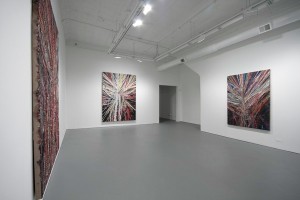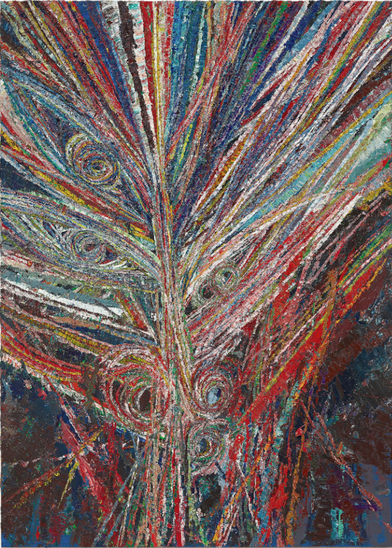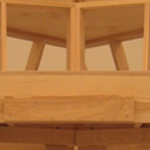Mark Grotjahn at Shane Campbell Gallery

L.A.-based artist Mark Grotjahn has become widely renowned over the past decade for his “Butterfly” paintings. In this ongoing series, Renaissance perspectival techniques are used to create symmetrically composed radial patterns, with two or more vanishing points. Often containing subtle variations on a single pantone-derived color (like hot fuchsia, dusky indigo, ivory white), and painted with great precision, these works radiate order and composure. As such, they seem like glamorous updates on a particularly austere strain of geometric abstraction, a legacy that runs from Malevich to Reinhardt to LeWitt.

It was quite a surprise, then, to encounter Grotjahn’s new exhibition at Shane Campbell Gallery last month, “Three to Five Faces.” Here, the Apollonian reserve of his previous works is supplanted with feral, Dionysian energy, resulting in a show that’s as pleasurable as it is unexpected.
Each of the five large, vertically-formatted paintings (oil on cardboard, mounted on canvas) is a dense polychromatic skein, comprised of thick, rope-like lines of paint that have been applied with a palette knife. Each line is a uniform hue — primary colors abound, along with greens, grays and whites — and most stretch or curve diagonally across the picture plane, forming tense, dynamic compositions. Embedded within these impastoed tangles are sets of shapes that suggest the basic schematics of a face: almond-shaped eyes, cartoon noses, spherical nostrils (strangely, none of these paintings depict any mouths). But these visages have nothing to do with human likeness. Instead, they suggest zoomorphized masks, ironically recalling early modernism’s fascination with the “primitive,” particularly, the work of Picasso, Nolde, and Roualt.
As implied by the exhibition’s title, most of these paintings contain more than one visage; eyes and noses overlap and jostle for attention, resulting in facial features as abstract as the grounds in which they’re submerged. For example, Untitled (Hidden Tea, Face 41.30) contains multiple outlines of blank orbs and elongated proboscides, rendered in ashen whites and lemon yellows, over a mottled ground of alizarin crimson and muted phathlo blue. Although all the energy is directed towards the center of the picture, there is no resting point; as soon as you start to decipher one form, you’re immediately drawn to another. And another. The effect is kaleidoscopic and dizzying.

Untitled (Broken Down Beautiful Post Impressionist Face 41.71) is more structured, but no less wild. The upper half contains a group of leering eyes – in this case, with eyeballs – stacked on top of one another, while the lower half is a smattering of snouts. Only one painting, Untitled (Nagel Cover Face 41.62), could be considered remotely “representational,” in that it only depicts a single face. Overall, this work suggests some strange, simian-like beast, furtively peering through a candy-colored thicket.
As intriguing as these paintings are as pictures, their true subject seems to be the alchemical nature of the stuff from which they’re made. In reproduction they might look matte and dry — almost as though they’re mere collages made with colored pipe cleaners — but in the “flesh,” they’re imposing and viscous, with an undeniable visceral charge. And surprisingly, these heavily worked surfaces still invoke deep recessional space, an effect that recalls the abstract fields of Pollock, Tobey and Riopelle.
Grotjahn spent years refining his “Butterfly” paintings, and it’ll be interesting to see if he does the same with this series of works. Already, he’s set a wildly exciting precedent. These “Face” paintings demonstrate a deft conflation of form, content and materiality that results in a deeply immersive viewing experience. Once you’ve encountered the strange, primordial power of these works, it’s hard to step away.
Mark Grotjahn
May 13 – June 25, 2011
Shane Campbell Gallery
673 N Milwaukee Ave
www.shanecampbellgallery.com






